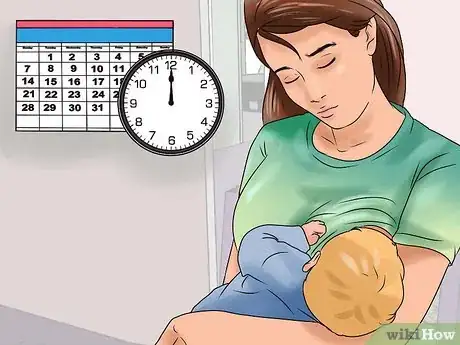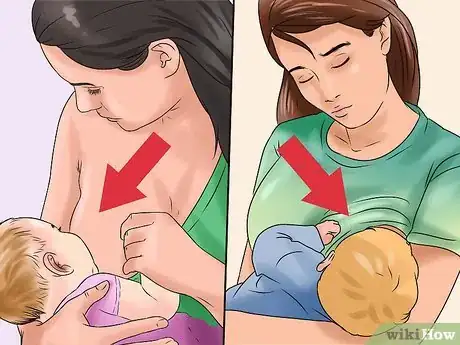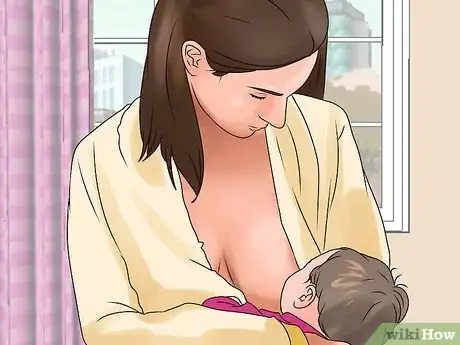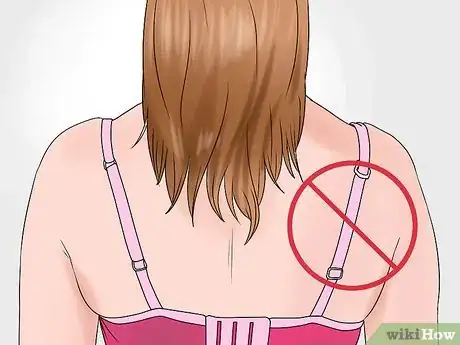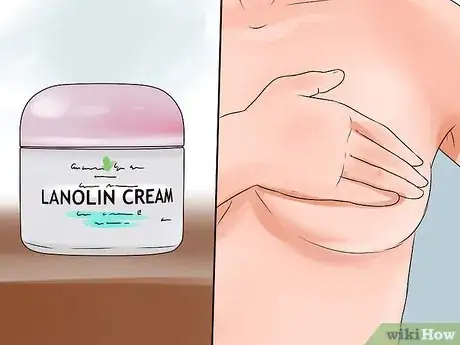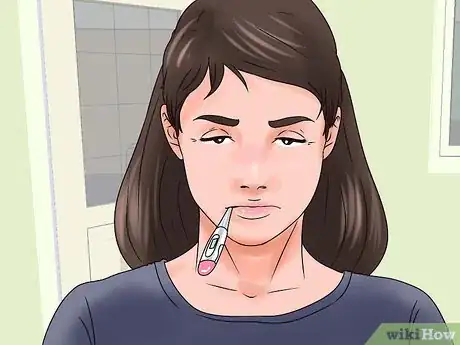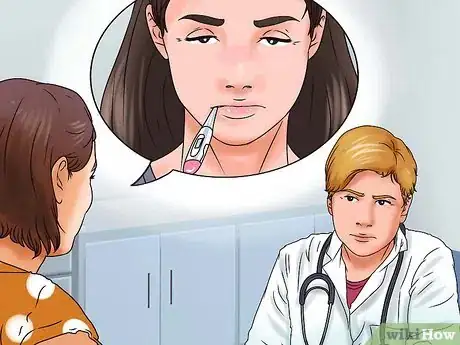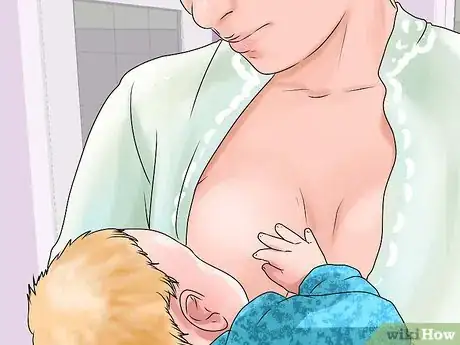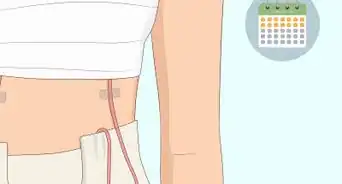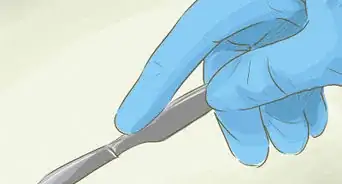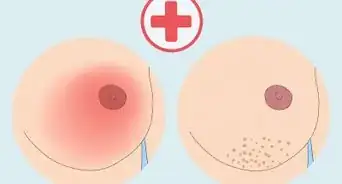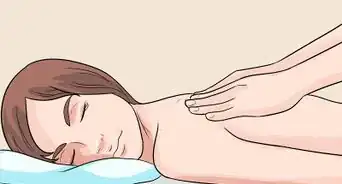This article was medically reviewed by Lacy Windham, MD. Lacy Windham, MD, is a Board-Certified Obstetrician & Gynecologist in Cleveland, Tennessee. Dr. Windham attended medical school at the University of Tennessee Health Science Center in Memphis. Her residency was completed at Eastern Virginia Medical School in Norfolk, Virginia. She was the recipient of multiple awards during her residency training, including Most Outstanding Resident in Maternal Fetal Medicine, Most Outstanding Resident in Oncology, Most Outstanding Resident Overall, and Special Award in Minimally Invasive Surgery.
This article has been viewed 100,580 times.
Mastitis is inflammation of the breast tissue, causing the breast to feel painful and swollen. It occurs commonly among nursing mothers, when bacteria enters the breast through sore, cracked nipples, or as a result of milk left in the breast after a feeding.[1] Mastitis can be prevented with the proper care of your breasts and nipples and by breastfeeding properly.
Steps
Learning to Breastfeed Correctly
-
1Learn about how to breastfeed from a healthcare professional. Mastitis can develop at any point during the nursing process, but many women who experience it in the first four weeks of nursing, when their breasts are still very engorged. It occurs more often in first-time mothers who are new to breastfeeding. Speak to your physician or midwife about how to breastfeed properly so you can prevent mastitis.[2]
- At the beginning of your pregnancy, your doctor or midwife will likely provide you with handouts and information booklets preparing you for pregnancy, delivery, breastfeeding, and the first few weeks with your new baby. If she doesn't offer these materials to you, ask for them.
- After the baby is born, don't hesitate to talk to a medical professional if you need help learning to breastfeed. It's important that you start your time as a mother by learning how to breastfeed properly to ensure your baby gets the nutrients she needs and to prevent mastitis.
-
2Maintain a breastfeeding schedule. Having consistent feeding times will prevent your breasts from becoming too full of milk. A full breast can lead to engorgement, which can lead to an episode of mastitis. You should breastfeed every one to three hours, or whenever your baby is hungry.[3]
- If you know you're going to have to miss a feeding, pump your milk to empty your breasts at the scheduled time for the feeding. If your breasts feel full before the regularly scheduled feeding time, it's important to empty them. If milk sits in your breasts, it will thicken, impeding flow and possibly lead to mastitis.[4]
- You don't have to wait for your baby to tell you it is feeding time. Your baby will more likely than not nurse a little when offered the breast. Don't be afraid to wake your baby if you have to. It is better to interrupt baby's sleep and drain the breast than to put yourself at risk of developing mastitis.
Advertisement -
3Allow your baby to nurse for as long as necessary to empty your breasts of milk. All babies have different nursing needs and all mothers have different milk supplies. Some babies will drain a breast entirely in 10 minutes while others can suckle for up to 30 minutes on each breast. Get to know your baby's nursing needs and allow him the time he needs to empty your breasts completely.[5]
- Do not put a time limit on how long you allow your baby to nurse. It's important to spend the amount of time it takes to completely drain your breasts of milk during each feeding. Most babies will release the breast when they are finished feeding, so do not remove your breast before your baby finishes.[6]
-
4Begin each nursing session with the opposite breast. If you offered the left breast first during the previous feeding, offer the right breast first for the next feeding. Rotating between the two breasts reduces your chances of getting mastitis.[7]
- Sometimes it can be confusing to remember which breast you left off with. Some mothers find it helpful to wear a “nursing bracelet” on the wrist of the breast they offered first. You can buy nursing bracelets at maternity stores, or use a bracelet you already own as your “nursing bracelet.”
-
5Make sure your baby is latching on correctly to your breast. Improper latching can affect the nipple and interfere with the proper flow of milk.[8] Check through your resources for information on proper latching techniques. If your baby is having difficulty latching on, consult your doctor or a lactation consultant.
- In order to latch correctly, your baby should be positioned upright, with her chest to your chest. You can raise your breast with your hand while you feed to help encourage the milk to flow to your baby. You can also massage your breast gently before allowing baby to latch on to help the milk flow downward.
- If your areolas are flat, massage your nipples to help them stand out so your baby can latch onto them correctly.
-
6Switch positions for each feeding session. Experiment with different feeding positions and incorporate pillows into the feeding session for comfort and ease of nursing. This also helps to ensure your breasts are fully drained at the end of each feeding.
- Choose positions that allow the milk to flow downward to your baby. For example, you can try feeding while lying on your left side to help prevent blockage on the right side of either breast. You can also try feeding on all fours by kneeling over your baby.
-
7Avoid giving bottles to your baby in-between feedings. You want to empty the breasts as much as possible to prevent mastitis, so do not give your baby bottles between feedings as this will lessen his appetite at feeding time.[9]
- As well, offering a bottle may cause nipple confusion as your baby tries to transition back and forth between the two types of nipples. If you give your baby a bottle between feedings, he may come to prefer sucking from a bottle, because the milk flows much faster. He may also reject your breast or have difficulty sucking from your breast.
Keeping Your Body Healthy
-
1Get at least eight hours of sleep. As a new mother, you will likely be overwhelmed with the care required for your new baby. In addition to taking care of your baby's needs, it's important that you also meet your own needs and get lots of rest. If you are feeling overly tired, ask your partner to watch the baby and take a quick 10-minute break so you can take a rest and relax. Stress and lack of sleep can contribute to a low immunity to infections and lead to the development of mastitis.[10]
- When sleeping at night, try to sleep on your back to avoid putting pressure on your breasts and do not wear a bra to bed. This can place pressure on sensitive milk ducts, which can cause them to become inflamed. If inflammation occurs, the milk ducts can become clogged, which can then lead to mastitis.
- If you like to sleep on your side, use a body pillow to help you get into a comfortable position that doesn't put pressure on your breasts.
-
2Avoid wearing tight-fitting tops or bras throughout the day. Go braless as often as possible to avoid added pressure on the milk ducts. Wear loose, comfortable clothing so you don't put pressure on your breasts.[11]
- If you do wear a nursing bra, it should be properly fitted to your body. You should be able to lean forward when putting on the bra so your entire breast falls in the bra cup. There should be no breast tissue punched at the edges of the cup or bra.
- You should avoid wearing other constricting clothing like tight bathing suits, breast pads, and placing heavy shoulder purses or diaper bags across your chest.
-
3Take care of cracked nipples. It's very common for your nipples to crack while you're nursing, and cracked nipples provide an entryway for bacteria to get in and cause mastitis. Prevent cracked nipples by doing the following:
- Let your nipples air dry after feedings. This is better for them than toweling them dry or washing them off each time, which can be drying.
- Rub your nipples with a lanolin cream. Look for a natural, alcohol-free cream that you can use to treat dry, sore nipples.
Recognizing the Symptoms of Mastitis
-
1Note if you develop flu-like symptoms or feel ill and run down. Many mothers with mastitis start to feel like they have the flu, with symptoms like a high fever, body aches, chills, and exhaustion. This is the is the most common presentation for mastitis.[12]
- Take your temperature if you are feeling ill and think you may have mastitis. A temperature above 101 °Fahrenheit (38.3 °C) can be an indication that you have mastitis.
-
2Check your breasts for inflammation, redness, or swelling. These symptoms often occur when a milk duct is clogged prior to the development of mastitis. Detecting these symptoms early can help you take steps to treat the problem before full blown mastitis develops.[13]
- The skin of your breasts may also appear shiny and have red streaks or red wedge shaped marks. Your breasts may also feel tender and warm to the touch and it may feel painful when you try to breastfeed.
- Mastitis usually occurs in the first few weeks of breastfeeding, though it can occur any time during breast feeding. Keep in mind mastitis tends to affect only one breast.
-
3See a doctor if your symptoms do not improve. If your breasts are not improving, you continue to have a high temperature or you are feeling more ill as time passes, chances are you are dealing with a mastitis infection and should seek immediate medical care.[14]
- If the doctor determines that the mastitis is the result of an infection, she may prescribe a round of antibiotics.
- Mastitis can turn into an abscess which is very difficult to treat and may involve disfiguring surgery, so it is important to see the doctor as soon as you feel like mastitis is developing.
-
4Keep breastfeeding. You will need to continue breastfeeding, even if you have an infection. You will not pass the infection to the baby. Not breastfeeding when you have mastitis can make the infection worse. Talk with your doctor about ways to minimize the pain.
References
- ↑ http://www.nhs.uk/Conditions/Mastitis/Pages/Introduction.aspx
- ↑ http://www.nhs.uk/Conditions/Mastitis/Pages/Introduction.aspx
- ↑ http://www.webmd.com/women/tc/preventing-mastitis-topic-overview
- ↑ http://www.mayoclinic.org/diseases-conditions/mastitis/basics/prevention/CON-20026633
- ↑ https://www.breastfeeding.asn.au/bf-info/common-concerns%E2%80%93mum/mastitis?q=bf-info/common-concerns%E2%80%93mum/mastitis
- ↑ http://www.nhs.uk/Conditions/Mastitis/Pages/Introduction.aspx
- ↑ https://www.breastfeeding.asn.au/bf-info/common-concerns%E2%80%93mum/mastitis?q=bf-info/common-concerns%E2%80%93mum/mastitis
- ↑ http://www.mayoclinic.org/diseases-conditions/mastitis/basics/prevention/CON-20026633
- ↑ https://www.breastfeeding.asn.au/bf-info/common-concerns%E2%80%93mum/mastitis?q=bf-info/common-concerns%E2%80%93mum/mastitis
- ↑ https://www.breastfeeding.asn.au/bf-info/common-concerns%E2%80%93mum/mastitis?q=bf-info/common-concerns%E2%80%93mum/mastitis
- ↑ https://www.breastfeeding.asn.au/bf-info/common-concerns%E2%80%93mum/mastitis?q=bf-info/common-concerns%E2%80%93mum/mastitis
- ↑ http://www.nhs.uk/Conditions/Mastitis/Pages/Introduction.aspx
- ↑ http://www.mayoclinic.org/diseases-conditions/mastitis/basics/symptoms/con-20026633
- ↑ http://www.mayoclinic.org/diseases-conditions/mastitis/basics/symptoms/con-20026633
About This Article
To prevent mastitis, try to keep a regular feeding schedule, since mastitis can develop when your breasts are too full of milk. Additionally, alternate which breast you offer at each feeding to prevent to prevent a build-up of milk in one breast. You should also avoid giving your baby a bottle between feedings as this will reduce its appetite and cause it to leave milk in your breast. Make sure to wear loose-fitting clothes, and avoid wearing bras if possible to reduce the pressure on your milk ducts. For tips on how to recognize the symptoms of mastitis, keep reading!

